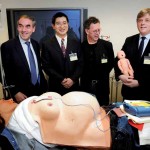 17 december 2009 – Er is veel kraamvisite, veelal gewapend met camera’s, aanwezig bij de geboorte van Medsim op donderdag 10 december. Medsim is niet zomaar een baby; het is het eerste bevallingssimulatiecentrum ter wereld. De trainingsruimtes zijn gevestigd op twee verdiepingen in Kennispoort en minister Maria van der Hoeven kwam het lintje, in de vorm van een buikwand, doorknippen. De TU/e is niet alleen verhuurder van de locatie, ze levert ook de nodige techniek. [Read more: HTML, PDF]
17 december 2009 – Er is veel kraamvisite, veelal gewapend met camera’s, aanwezig bij de geboorte van Medsim op donderdag 10 december. Medsim is niet zomaar een baby; het is het eerste bevallingssimulatiecentrum ter wereld. De trainingsruimtes zijn gevestigd op twee verdiepingen in Kennispoort en minister Maria van der Hoeven kwam het lintje, in de vorm van een buikwand, doorknippen. De TU/e is niet alleen verhuurder van de locatie, ze levert ook de nodige techniek. [Read more: HTML, PDF]
Author: hj
We Touch Pillow: The pillow that communicates family presence through warmth without an obliged effort for the user
by Sophie van der Weerd, [PDF | 2M]
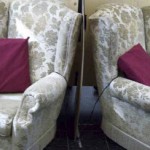
In her B22 project report, Sophie writes: “…I will offer the ‘WeTouch Pillow’; the pillow that communicates your families’ presence in a subtle way without an obliged effort. If one uses his pillow, the pillow of the other becomes warmer and vice versa. I will focus upon the communication tools market. The market will have a need for my product, since it communicates family presence without an obligation and current communication tools require an obligation and effort, which people do not like when communicating with their family like having to call, as to my user research. I want to express to the market the importance of family presence and contact, but that there is no obliged effort needed. The internet will be a good medium to use to contact the target group of relatives living apart, since the younger generations uses it a lot. And I try to reach people who live apart from each other, so an internet service which sends one pillow to each of the relatives is a good way to sell the WeTouch Pillow. Also because an internet connection is needed for the pillows to connect…”
Art across Realities: helping painters to generate more profit by selling their painting process
Final Bachelor Project by Ruben Hekkens. Report: [PDF, 4M]
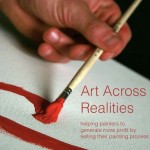
FULLTEXT: PDF
Collaboratory: working together over a distance
Final USI project by Li Li. Report: [PDF, 1.8M]
The Collaboratory software system at FEI Company allows customers to work together with an electron microscope over a distance, and to share the instruments, microscopy expertise and services. It originally has been developed from the results of the Collaboratory.nl project.
Continue reading Collaboratory: working together over a distance
Het nieuwe spel van Serge Offermans: “Blurring the boundaries”
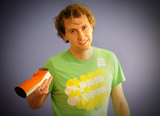
The new game designed by Serge Offermans featured in Cursor. The game is the result of his final master project “Blurring the boundaries”. In his final report (PDF, 2M),
“Digital virtual worlds are important to the people living in them. They allow people to use other means to exploit their capabilities. Who they are, what they can do and what they experience in these worlds however, is hardly ever valuable outside the virtual. This project aimed to create an integration of the qualities of the virtual and the physical world, and in doing so allow benefit from one world in the other.
The result is a virtual world, designed specifically with integration of the worlds in mind. It literally draws the virtual world into the physical by bounding it to our physical reality and effectively placing virtual, invisible characters and objects in our physical world.
Interaction with the world is made possible by a device that channels audio from one world to the other and allows you to ‘feel’ and manipulate the world through movement and touch.
The specific world that has been worked out is designed for the use by children and their parents who can now benefit from the dynamic-ness of the virtual world without the closed medium of the PC.
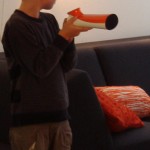
Children and parents can now together experience the virtual world and spend time together while they are engaged in activities that also benefit the childs educational development. Because the world can only be perceived through touch and audio, the world stimulates the child’s imagination.”
“Scientometric Analysis Of The CHI Proceedings” on SIGCHI homepage
Developing Novel Extensions to Support Prototyping for Interactive Social Robots
Martijn ten Bhömer, Christoph Bartneck, Jun Hu, Rene Ahn, Tuyls, Karl, Frank Delbressine, and Loe Feijs
Abstract – Lego Mindstorms NXT is a platform highly suitable for prototyping in the field of interactive social robotics. During a technology masterclass at Eindhoven University of Technology students from the department of Industrial Design have developed five novel extensions (sensors and actuators) for the Lego Mindstorms NXT which extend the ability of Lego to prototype for robotics even further. Applications include a water-pump, GPS sensor, wireless sensor bridge, optical mouse sensor and a magnetic grabber. In this paper we will present these extensions and showcase applications in which these extend possibilities of Lego Mindstorms NXT to a new level.
Keywords: robot, Lego, Mindstorms, NXT, social, prototyping
FULLTEXT: PDF HTML REFERENCE: BibTeX EndNote
LIVE HISTORY – A Vision for the Nationaal Historisch Museum (NHM)
This video shows a vision on how visitors could experience the upcoming Nationaal Historisch Museum. The video was created by the Department of Industrial Design at the Eindhoven University of Technology. More information is available at http://nhm.id.tue.nl/
AdMoVeo: An Educational Robotic Platform for Learning Behavior Programming
This video, made by Sjriek Alers, has been shown as part of a Demo on DeSForM 360, the 5th International Workshop on Design & Semantics of Form & Movement October 26 & 27, 2009 Taipei, Taiwan. It is a compilation of some of the student work for the assignment Creative Programming for designers (Creapro) Showing what the students have learned in behavioral programming with the AdMoVeo robot platform and using the Arduino.
[youtube]http://www.youtube.com/watch?v=O3e0VzHyAkA[/youtube]
Most of the design students do not have inherent affinity towards programming and electronics. The AdMoVeo robotic platform is designed, purely for teaching the industrial design students basic skills of programming and for motivating and encouraging the design students to explore their creativity with their passions in graphical and behavioral design.
Danah Boyd: Remarks from Panel on “Scientometric Analysis of the CHI Proceedings” at CHI 2009
Danah had some very interesting remarks with regard to our paper “Scientometric Analysis of the CHI Proceedings”. See http://www.danah.org/papers/talks/CHI2009.html.
FULLTEXT: PDF HTML REFERENCE: BibTeX EndNote
DOI: 10.1145/1518701.1518810